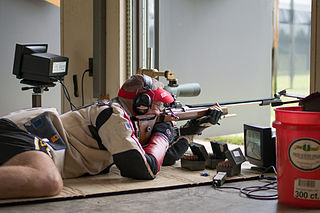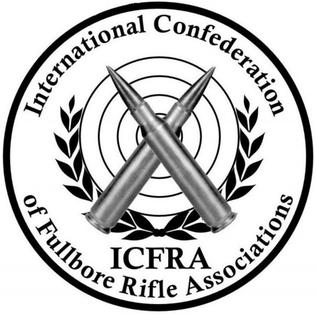
Shooting sports is a group of competitive and recreational sporting activities involving proficiency tests of accuracy, precision and speed in shooting — the art of using ranged weapons, mainly small arms and bows/crossbows.
The Accuracy International Arctic Warfare rifle is a bolt-action sniper rifle designed and manufactured by the British company Accuracy International. It has proved popular as a civilian, police, and military rifle since its introduction in the 1980s. The rifles have features that improve performance in extremely cold conditions without impairing operation in less extreme conditions.

The .308 Winchester is a smokeless powder rimless bottlenecked rifle cartridge widely used for hunting, target shooting, police, military, and personal protection applications globally. It is similar, but not identical, to the 7.62×51mm NATO cartridge.

Metallic silhouette shooting is a group of target shooting disciplines that involves shooting at steel targets representing game animals at varying distances, seeking to knock the metal target over. Metallic silhouette is shot with large bore rifles fired freehand without support out to 500 meters, and with large bore handguns from the prone position with only body support out to 200 meters. Competitions are also held with airguns and black-powder firearms. A related genre is shot with bow and arrow, the metal targets being replaced with cardboard or foam. The targets used are rams, turkeys, pigs, and chickens, which are cut to different scales and set at certain distances from the shooter depending on the specific discipline.

Benchrest shooting is a shooting sport discipline in which high-precision rifles are rested on a table or bench – rather than being carried in the shooter's hands – while shooting at paper or steel targets, hence the name "benchrest". Both the forearm and buttstock of such a rifle are usually fully supported by bean bags, a bipod/monopod (front/rear) combination, and/or a specially designed fixture device called shooting rest, so that the gun can remain stably pointing at the target without needing to be held by someone. When shooting, the shooter simply sits/stands comfortably behind the table/bench, operates the action and pulls the trigger, without needing to worry about carrying any weight of the gun. This is in contrast to other shooting disciplines, where the shooter has to bear at least part of the gun's weight while holding it steady to aim, even when using support devices such as bipods, tripods or shooting sticks.

NRA Precision Pistol, formerly known as NRA Conventional Pistol, is a national bullseye shooting discipline organized in the United States by the National Rifle Association of America. Emphasis is on accuracy and precision, and participants shoot handguns at paper targets at fixed distances and time limits. Other organizations in the United States and Canada have established rules and keep records of similar disciplines, including the Civilian Marksmanship Program (CMP) in the United States.
The Sako TRG is a bolt-action sniper rifle line designed and manufactured by Finnish firearms manufacturer SAKO of Riihimäki. It is the successor to the SAKO TR-6 target rifle, and thus the letter G within the rifle's name is meant to represent number 7.
The Elcho Shield is an annual long range shooting competition between national teams of eight from England, Scotland, Ireland and Wales. The trophy holder was originally able to choose the venue of the competition, however, since the NRA's move to Surrey from Wimbledon in 1890, the competition has been held at National Shooting Centre, Bisley in Surrey, England. It is usually contested during the NRA Imperial Meeting.

High Power Rifle, also called XTC from "Across the Course", is a shooting sport using fullbore target rifles which is arranged in the United States by the National Rifle Association of America (NRA). The sport is divided into classes by equipment, and popular types of matches include Service Rifle, Open, Axis and Allies and metallic silhouette. The term High Power Rifle sometimes also includes the international shooting disciplines of Palma and F-Class by the International Confederation of Fullbore Rifle Associations (ICFRA) which are represented by the NRA in the United States.
The SIG Sauer 200 STR, also known as the SIG Sauer 200 STR Match, is a bolt-action rifle mostly used as a target/competition rifle for national competitions by Norwegian, Swedish and Danish sport shooters. It is a variant of the Sauer 200 TR or SIG Sauer 200 TR Match rifle that features thicker 19 mm (0.75 in) diameter barrels. The 200 STR is produced by J. P. Sauer & Sohn GmbH in Germany.

Smallbore rifle shooting, sometimes known as miniature rifle shooting, is a set of disciplines of shooting sports. Smallbore shooting uses smaller-calibre rifles, typically chambered in .22 Long Rifle, at ranges generally of 100 yards (91 m) or shorter. Depending on the range, it can either be conducted indoors or outdoors.
The Swing rifle was a design developed by a number of target shooting enthusiasts who came together in 1970 at Bisley. The design's primary instigators were George Swenson and Laurie Ingram. At the time target rifle competition in the UK was dominated by designs based on military actions such as those of the Lee–Enfield and Mauser 1898. These designs were felt to have reached the limits of their development potential; especially when combined with commercially manufactured or hand-loaded ammunition.

Long range shooting is a collective term for shooting disciplines where the distance to target is significant enough that shooter has to put effort into calculating various ballistic factors, especially in regards to the deviating effects of gravity and wind. While shooting at shorter ranges, a shooter only has to slightly adjust the sights to compensate for limited bullet drop at most, but when the range is extended, wind drift will be the first factor affecting precision to the extent that it must be taken into serious account. Some would argue that long range shooting starts where assessment of wind, distance and various atmospheric conditions are equally important for the results as pure shooting skills - meaning that even if one conducts a technically perfect shot, the shooter will miss the target because of incorrect calculations, neglecting to take some elements into consideration, or merely due to unpredictable downrange conditions. It is widely accepted within interdisciplinary circles that for a standard rifle firing full-powered cartridges, "long range" means the target is more than 600 m (660 yd) away,, while "extreme long range" is generally accepted as when the target distance is more than 1,000 m (1,100 yd) away from the shooter.

The National Shooting Centre is the UK's largest shooting sports complex, comprising several shooting ranges as well as the large "Bisley Camp" complex of accommodation, clubhouses and support services. The centre is located near the village of Bisley in Surrey from which it takes its colloquial name "Bisley ranges". The site is wholly owned by the National Rifle Association (NRA). The NSC is the trading name of the facility.

Bullseye shooting is a category of shooting sport disciplines where the objective is to score points with carefully placed precision fire by hitting a target as close to its center as possible. The name refers to the target center's nickname, the "bull's eye". In Scandinavia, this type of shooting competition is referred to as Range-Shooting, as it usually takes place at dedicated shooting range.
The NRA Whittington Center is one of the largest and most comprehensive shooting facilities in the United States. Owned and operated by the National Rifle Association of America (NRA), the centre is located in the Sangre de Cristo Mountains of Colfax County, New Mexico. Ten percent of the 33,300-acre (13,500 ha) site has been developed to include twenty-three shooting ranges, an administration building, a cafeteria, a museum, a library, classrooms, and full-service hookups for 175 recreational vehicles. The remainder of the site provides wildlife habitat at elevations above 6,300 feet (1,900 m) with primitive camp-grounds and remote back-country cabins for hunting, bird watching, wildlife viewing, photography, hiking, mountain biking, and horseback riding.

The International Confederation of Fullbore Rifle Associations (ICFRA) is the international association for the fullbore rifle shooting sports of Target Rifle ('TR') (in the US 'Palma' Rifle) and F-Class, which are long range competitions shot at distances between 300 and 900 meters or 300 to 1,000 yards depending on the range. F-Class shooters often shoot concurrently with the world's long-range TR shooters and use the same targets, except that the F-Class target has an extra ring half the diameter of the smallest in use for TR. ICFRA manages the programme of World Championships and other major matches for Fullbore Rifle and seeks to standardize the competition rules for TR and F-Class around the world.

Shooting competitions for factory and service firearms refer to a set of shooting disciplines, usually called service rifle, service pistol, production, factory, or stock; where the types of permitted firearms are subject to type approval with few aftermarket modifications permitted. The terms often refer to the restrictions on permitted equipment and modifications rather than the type of match format. The names Service Rifle and Service Pistol stem from that the equipment permitted for these types of competitions traditionally were based on standard issue firearms used by one or several armed forces and civilian versions of these, while the terms production, factory and stock often are applied to more modern disciplines with similar restrictions on equipment classes.
The sport of rifle shooting at Cambridge University has been practised since at least the early 19th century. Beginning as part of the military training of the Cambridge University Rifle Volunteers, it has since been conducted by a number of student clubs, and is currently carried out predominantly by the Cambridge University Rifle Association and Cambridge University Small Bore Club, with some participation by the Cambridge University Revolver and Pistol Club for the discipline of gallery rifle.
The Imperial Meeting is a major annual target shooting competition hosted by the National Rifle Association on the historic Bisley Camp in England.














